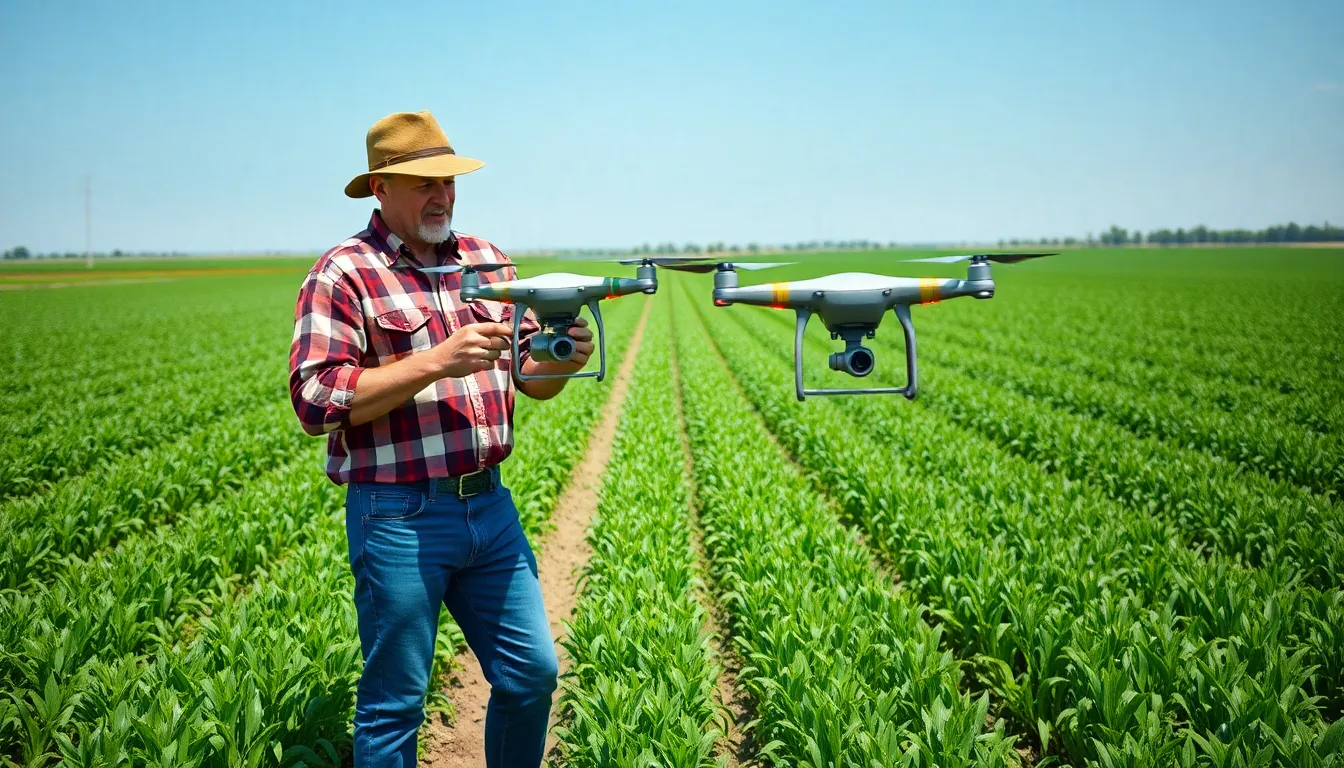Table of Contents
ToggleIn a world where farmers are swapping pitchforks for smartphones, smart agriculture technology is revolutionizing the way we grow food. Imagine a field of crops monitored by drones and sensors, all while farmers sip coffee and check their apps. It’s not just sci-fi; it’s happening now, and it’s making farming more efficient, sustainable, and yes, a whole lot cooler.
Overview of Smart Agriculture Technology
Smart agriculture technology encompasses advanced tools and techniques that enhance farming efficiency. Drones play a crucial role in monitoring crop health, providing real-time data to farmers. Sensors in the soil measure moisture levels, guiding irrigation decisions. This combination of technology helps optimize resource usage, reducing waste and increasing yields.
Data analytics streamlines decision-making by processing vast amounts of information. Farmers can now make informed choices about planting schedules and pest control measures. GPS technology aids in precision farming, allowing for targeted applications of fertilizers and pesticides.
Additionally, automation is changing traditional farming practices. Robotic systems assist with planting, harvesting, and weeding tasks, minimizing labor costs and effort. These developments contribute to a more sustainable agricultural model.
Smart agriculture technology also promotes environmental stewardship. By minimizing chemical usage and conserving water, farmers can reduce their ecological footprint. This approach aligns with the growing demand for sustainable food practices.
Adoption of smart technology in agriculture varies by region and scale of operation. Larger farms often leverage these technologies to maximize efficiency, while smaller farms may adopt specific tools as needed. Innovative startups in the agricultural tech space help bridge gaps by providing affordable solutions for various farming activities.
Smart agriculture technology transforms farming through increased efficiency, sustainability, and innovation. The integration of these tools significantly benefits the agricultural industry, paving the way for the future of food production.
Benefits of Smart Agriculture Technology
Smart agriculture technology offers significant advantages to modern farming practices. It enhances operational functions, increases productivity, and promotes sustainability.
Increased Efficiency
Automated systems streamline various farming tasks. Drones enable efficient monitoring of extensive fields, while soil sensors provide real-time moisture data. These tools allow farmers to make quick decisions about irrigation and fertilization. Less time spent on manual labor translates to more hours available for strategic planning. Additionally, resource optimization leads to lower operational costs and reduced waste. By harnessing data analytics, farmers gain valuable insights, enabling smarter interventions. Precision farming techniques also reduce the volume of inputs needed, enhancing overall efficiency.
Enhanced Crop Yields
Crop yields improve significantly with smart agriculture technology. Sensors help identify nutrient deficiencies and optimize growing conditions, allowing crops to thrive. Drones provide timely assessments of plant health, enabling targeted treatment and pest management. More precise applications of fertilizers increase nutrient absorption and decrease runoff. Larger harvests contribute to food security, meeting growing global demand. Furthermore, automation in planting and harvesting ensures that crops are processed quickly and efficiently, minimizing losses. Adopting these advanced technologies cultivates not only higher yields but also more resilient farming systems.
Key Technologies in Smart Agriculture
Smart agriculture technology relies on various advanced solutions that enhance farming practices. Key technologies include IoT, drones, and artificial intelligence, each contributing uniquely to agricultural efficiency.
IoT and Sensors
IoT devices and sensors play a crucial role in smart agriculture. These tools collect real-time data about soil conditions, crop health, and environmental factors. They enable farmers to monitor moisture levels, temperature, and nutrient content effectively. Decision-making improves as farmers receive accurate insights on irrigation and fertilization needs. Enhanced data collection helps prevent water waste and optimizes resource usage. Consequently, farmers can address issues promptly, leading to healthier crops and increased yields.
Drones and Aerial Imaging
Drones revolutionize crop management by offering aerial imaging capabilities. Equipped with high-resolution cameras, drones capture detailed views of fields, revealing vital information about plant health. They assist in identifying areas that require attention, such as pest outbreaks or nutrient deficiencies. Farmers can analyze this data to make informed decisions about when to apply fertilizers and pesticides. Efficient crop monitoring promotes sustainable farming practices, reducing chemical usage and minimizing environmental impact. Using drones ultimately enhances productivity by providing timely insights that promote better crop management.
Artificial Intelligence
Artificial intelligence contributes significantly to smart agriculture by automating tasks and improving predictions. AI algorithms analyze vast amounts of data gathered from various sources, including sensors and drones. This analysis allows for accurate forecasting of yields, pest attacks, and weather patterns. As a result, farmers can implement proactive measures to mitigate risks and optimize harvests. Automation also streamlines repetitive tasks, such as planting and harvesting, reducing labor costs and improving efficiency. Enhanced decision-making fosters a resilient agricultural system, supporting sustainability and meeting the demands of a growing population.
Challenges and Limitations
Smart agriculture technology presents various challenges and limitations that farmers encounter while adopting these innovations.
Cost and Accessibility
High initial costs represent a significant barrier for many farmers, especially those operating smaller farms. Purchasing drones, sensors, and advanced machinery requires substantial investment. Accessibility to this technology also varies by region, causing disparities in adoption rates. Financial constraints can hinder smaller farms from integrating smart solutions effectively. Nevertheless, innovative startups increasingly offer affordable options, helping to bridge the gap between large and small farming operations.
Data Management Issues
Data management poses another challenge within smart agriculture. Collecting vast amounts of data creates complexities for farmers trying to analyze and utilize the information effectively. Interoperability among various devices and platforms can complicate data integration. Farmers often struggle to make sense of the data without adequate training or support, potentially limiting decision-making benefits. Simplified data management tools can assist in overcoming these obstacles, enhancing the efficiency of smart agriculture systems overall.
Future Trends in Smart Agriculture Technology
Emerging trends in smart agriculture technology promise to enhance farming practices significantly. Precision agriculture is gaining traction, as farmers utilize satellite data for monitoring crop performance and optimizing field management. Advances in artificial intelligence play a crucial role by improving predictive analytics, enabling farmers to anticipate weather patterns and crop demands.
Integration of blockchain technology enhances supply chain transparency. Consumers increasingly demand to know how food is produced, and blockchain provides a reliable way to track food from farm to table. Augmented reality applications are also on the rise, allowing farmers to visualize crop conditions digitally and receive real-time guidance on interventions.
Vertical farming technology continues to evolve. Indoor farms utilize controlled environments to maximize yield in urban areas, minimizing land use and environmental impact. Developing robotic solutions are improving efficiency; automated harvesters and drones become standard tools for managing fields, enabling precise application of inputs.
Data-driven decisions remain a focal point. Adoption of advanced data analytics tools allows farmers to interpret large datasets more effectively, providing insights into crop health and resource management. Smart irrigation systems incorporate weather forecasts, delivering water only when necessary to conserve resources.
Sustainability initiatives are reshaping industry standards. Companies are investing in systems aimed at reducing carbon footprints and promoting biodiversity. Adoption rates of smart agriculture technology reflect these changes, with large farms leading the way but smallholders catching up through cooperatives and partnerships.
Innovation-driven startups continue to emerge, offering affordable smart farming solutions. With these emerging technologies, agriculture not only becomes more efficient but also aligns with modern sustainability goals. As these trends unfold, the future of smart agriculture technology appears brighter than ever.
Conclusion
Smart agriculture technology is reshaping the landscape of farming by integrating innovative tools that enhance productivity and sustainability. As farmers embrace these advancements they’re not only improving their operational efficiency but also contributing to a more sustainable food system. The ongoing development of technologies like precision agriculture and AI-driven analytics promises to further elevate farming practices.
While challenges such as high initial costs and data management persist, the rise of affordable solutions from startups is making these technologies more accessible. As adoption rates increase across various farm sizes the agricultural sector is poised for a significant transformation. The future of smart agriculture looks bright with potential solutions that align efficiency with the pressing need for sustainable practices.






